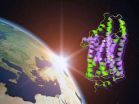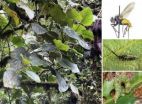(Press-News.org) Researchers have found that the melanopsin pigment in the eye is potentially more sensitive to light than its more famous counterpart, rhodopsin, the pigment that allows for night vision.
For more than two years, the staff of the Laboratory for Computational Photochemistry and Photobiology (LCPP) at Ohio's Bowling Green State University (BGSU), have been investigating melanopsin, a retina pigment capable of sensing light changes in the environment, informing the nervous system and synchronizing it with the day/night rhythm. Most of the study's complex computations were carried out on powerful supercomputer clusters at the Ohio Supercomputer Center (OSC).
The research recently appeared in the Proceedings of the National Academy of Sciences USA, in an article edited by Arieh Warshel, Ph.D., of the University of Southern California. Warshel and two other chemists received the 2013 Nobel Prize in Chemistry for developing multiscale models for complex chemical systems, the same techniques that were used in conducting the BGSU study, "Comparison of the isomerization mechanisms of human melanopsin and invertebrate and vertebrate rhodopsins."
"The retina of vertebrate eyes, including those of humans, is the most powerful light detector that we know," explains Massimo Olivucci, Ph.D., a research professor of Chemistry and director of LCPP in the Center for Photochemical Sciences at BGSU. "In the human eye, light coming through the lens is projected onto the retina where it forms an image on a mosaic of photoreceptor cells that transmits information from the surrounding environment to the brain's visual cortex. In extremely poor illumination conditions, such as those of a star-studded night or ocean depths, the retina is able to perceive intensities corresponding to only a few photons, which are indivisible units of light. Such extreme sensitivity is due to specialized photoreceptor cells containing a light sensitive pigment called rhodopsin."
For a long time, it was assumed that the human retina contained only photoreceptor cells specialized in dim-light and daylight vision, according to Olivucci. However, recent studies revealed the existence of a small number of intrinsically photosensitive nervous cells that regulate non-visual light responses. These cells contain a rhodopsin-like protein named melanopsin, which plays a role in the regulation of unconscious visual reflexes and in the synchronization of the body's responses to the dawn/dusk cycle, known as circadian rhythms or the "body clock," through a process known as photoentrainment.
The fact that the melanopsin density in the vertebrate retina is 10,000 times lower than that of rhodopsin density, and that, with respect to the visual photoreceptors, the melanopsin-containing cells capture a million-fold fewer photons, suggests that melanopsin may be more sensitive than rhodopsin. The comprehension of the mechanism that makes this extreme light sensitivity possible appears to be a prerequisite to the development of new technologies.
Both rhodopsin and melanopsin are proteins containing a derivative of vitamin A, which serves as an "antenna" for photon detection. When a photon is detected, the proteins are set in an activated state, through a photochemical transformation, which ultimately results in a signal being sent to the brain. Thus, at the molecular level, visual sensitivity is the result of a trade-off between two factors: light activation and thermal noise. It is currently thought that light-activation efficiency (i.e., the number of activation events relative to the total number of detected photons) may be related to its underlying speed of chemical transformation. On the other hand, the thermal noise depends on the number of activation events triggered by ambient body heat in the absence of photon detection.
"Understanding the mechanism that determines this seemingly amazing light sensitivity of melanopsin may open up new pathways in studying the evolution of light receptors in vertebrate and, in turn, the molecular basis of diseases, such as "seasonal affecting disorders," Olivucci said. "Moreover, it provides a model for developing sub-nanoscale sensors approaching the sensitivity of a single-photon."
For this reason, the LCPP group – working together with Francesca Fanelli, Ph.D., of Italy's Università di Modena e Reggio Emilia – has used the methodology developed by Warshel and his colleagues to construct computer models of human melanopsin, bovine rhodopsin and squid rhodopsin. The models were constructed by BGSU research assistant Samer Gozem, Ph.D., BGSU visiting graduate student Silvia Rinaldi, who now has completed his doctorate, and visiting research assistant Federico Melaccio, Ph.D. – both visiting from Italy's Università di Siena. The models were used to study the activation of the pigments and show that melanopsin light activation is the fastest, and its thermal activation is the slowest, which was expected for maximum light sensitivity.
The computer models of human melanopsin, and bovine and squid rhodopsins, provide further support for a theory reported by the LCPP group in the September 2012 issue of Science Magazine which explained the correlation between thermal noise and perceived color, a concept first proposed by the British neuroscientist Horace Barlow in 1957. Barlow suggested the existence of a link between the color of light perceived by the sensor and its thermal noise and established that the minimum possible thermal noise is achieved when the absorbing light has a wavelength around 470 nanometers, which corresponds to blue light.
"This wavelength and corresponding bluish color matches the wavelength that has been observed and simulated in the LCPP lab," said Olivucci. "In fact, our calculations also indicate that a shift from blue to even shorter wavelengths (i.e. indigo and violet) will lead to an inversion of the trend and an increase of thermal noise towards the higher levels seen for a red color. Therefore, melanopsin may have been selected by biological evolution to stand exactly at the border between two opposite trends to maximize light sensitivity."
The melanopsin research project was funded jointly by the BGSU Center for Photochemical Sciences and the College of Arts & Sciences, and, together with grants from the National Science Foundation and the Human Frontier Science Program, helped create the LCPP.
INFORMATION: END
Computer models help decode cells that sense light without seeing
BGSU's Olivucci leverages OSC systems to study retina's melanopsin pigment
2014-02-07
ELSE PRESS RELEASES FROM THIS DATE:
Variability of contact precaution policies in US emergency departments
2014-02-07
In a study published in Infection Control and Hospital Epidemiology on February 7, 2014, Daniel J. Pallin, MD, MPH and Jeremiah D. Schuur, MD, MS, surveyed a random sample of US emergency departments (EDs) and found substantial variation in the adoption of policies relating to contact precautions.
While most EDs have policies relating to contact precautions when specific organisms are suspected, a minority have such policies for the symptoms often caused by those organisms. This indicated that institutional policies do not mirror consensus recommendations by the CDC, ...
Panel issues report on gray wolf science
2014-02-07
(Santa Barbara, Calif.) — As the Endangered Species Act (ESA) celebrated its 40th anniversary at the end of 2013, its administrative agency, the U.S. Fish and Wildlife Service (USFWS), was mired in controversy. At issue was a proposal to remove the gray wolf (Canis lupus) from the List of Endangered and Threatened Wildlife and add the Mexican gray wolf (Canis lupus baileyi).
As a result, the USFWS sought an independent peer review of the science behind the proposed rule to delist the gray wolf species. The agency commissioned UC Santa Barbara's National Center for Ecological ...
Study shows drop in crime rates are less where Wal-Mart builds
2014-02-07
Communities across the United States experienced an unprecedented decline in crime in the 1990s. But for counties where Wal-Mart built stores, the decline wasn't nearly as dramatic.
"The crime decline was stunted in counties where Wal-Mart expanded in the 1990s," says Scott Wolfe, assistant professor of criminology and criminal justice at the University of South Carolina and lead author of a new study. "If the corporation built a new store, there were 17 additional property crimes and 2 additional violent crimes for every 10,000 persons in a county."
The study, titled ...
Researchers at UGent and VIB, discovered potential novel treatment against septic shock
2014-02-07
Septic shock is caused by excessive and systemic reaction of the entire body against infectious agents, in most cases of bacterial origin. The number of deaths by septic shock in intensive care units is very high and is still increasing, despite numerous large scale clinical trials. Scientists of VIB and UGent, supervised by Peter Vandenabeele, demonstrated in a mouse study that a potential novel treatment for sepsis may consist of the simultaneous neutralization of two harmful cytokines in the blood circulation, namely interleukin-1 and interleukin-18.
In the VIB research ...
Dating is refined for the Atapuerca site where Homo antecessor appeared
2014-02-07
One of the issues of the Atapuerca sites that generates the most scientific debate is the dating of the strata where the fossils are found. Therefore, researchers at the Spanish National Research Centre for Human Evolution, among others, strive to settle the dates. A study published by the 'Journal of Archaeological Science' has clarified that the sediment of Gran Dolina, where the first remains of Homo antecessor were discovered in 1994, is 900,000 years old.
The findings at the Lower Palaeolithic cave site of Gran Dolina, in the Sierra de Atapuerca mountain range (Burgos), ...
Protein structure: Peering into the transit pore
2014-02-07
The lipid-rich membranes of cells are largely impermeable to proteins, but evolution has provided a way through – in the form of transmembrane tunnels. A new study shows in unmatched detail what happens as proteins pass through such a pore.
Every cell is surrounded by a surface membrane and contains internal compartments bounded by membranes. Almost one-third of all proteins synthesized in cells must pass through these membranes or be incorporated into them in order to fulfil their functions. However, the fat-rich nature of membranes makes it impossible for most proteins ...
Beta blockers and perioperative care: EHJ editorial addresses controversy
2014-02-07
Zurich, 7 February 2014. Since the end of 2011 when the scientific work of Professor Don Poldermans was first scrutinized there has been controversy in the medical world about the use of beta blockers in perioperative care.
The recent publication - and retraction for proper peer reviewing and revision - in the European Heart Journal (EHJ) of a paper by Professors Cole and Francis from Imperial College, questioning whether beta blockers in perioperative care could lead to a mortality increase brought the topic back into the public eye.
The EHJ has published an editorial ...
The biomass of ocean mesopelagic fish is 10 times higher than estimated
2014-02-07
The total stock of fish on the planet had been reckoned until today to be around 2,000 million tonnes. About half of them were thought to be mesopelagic fish, in other words, ones found at depths of between 200 and 1,000 metres in ocean areas.
However, an international team*, in which AZTI-Tecnalia researchers are participating and which is being led by the doctor in oceanography Xabier Irigoien, has discovered that its abundance could be at least 10 times higher than the original estimate. The results have been published in the journal Nature Communications.
Mesopelagic ...
New plant species a microcosm of biodiversity
2014-02-07
Biologists working in the Andes mountains of Ecuador have described a new plant species, a wild relative of black pepper, that is in itself a mini biodiversity hotspot. The new species, Piper kelleyi, is the sole home of an estimated 40-50 insect species, most of which are entirely dependent on this plant species for survival. This discovery is part of a larger project which focuses on the influence of plant-produced chemical compounds on biodiversity. The study was published in the open access journal PhytoKeys.
The chemical compounds produced by plants are source of ...
Avian flu variant stalks Egypt
2014-02-07
Since its first identification in Asia, highly pathogenic avian influenza—H5N1—has caused significant alarm in the scientific community. While the virus' primary target is birds—tens of millions have already died from it—it is capable of infecting mammals, including humans, causing serious illness and a frightening rate of mortality.
In a new study, Matthew Scotch, a researcher at Arizona State University's Biodesign Institute, tracks the spread of an H5N1 variant in Egypt—a country recently identified as a major epicenter for the virus. In results recently appearing ...
LAST 30 PRESS RELEASES:
Statins significantly reduce mortality risk for adults with diabetes, regardless of cardiovascular risk
Brain immune cells may drive more damage in females than males with Alzheimer’s
Evidence-based recommendations empower clinicians to manage epilepsy in pregnancy
Fungus turns bark beetles’ defenses against them
There are new antivirals being tested for herpesviruses. Scientists now know how they work
CDI scientist, colleagues author review of global burden of fungus Candida auris
How does stroke influence speech comprehension?
B cells transiently unlock their plasticity, risking lymphoma development
Advanced AI dodel predicts spoken language outcomes in deaf children after cochlear implants
Multimodal imaging-based cerebral blood flow prediction model development in simulated microgravity
Accelerated streaming subgraph matching framework is faster, more robust, and scalable
Gestational diabetes rose every year in the US since 2016
OHSU researchers find breast cancer drug boosts leukemia treatment
Fear and medical misinformation regarding risk of progression or recurrence among patients with breast cancer
Glucagonlike peptide-1 receptor agonists and asthma risk in adolescents with obesity
Reviving dormant immunity: Millimeter waves reprogram the immunosuppressive microenvironment to potentiate immunotherapy without obvious side effects
Safety decision-making for autonomous vehicles integrating passenger physiological states by fNIRS
Fires could emit more air pollution than previously estimated
A new way to map how cells choose their fate
Numbers in our sights affect how we perceive space
SIMJ announces global collaborative book project in commemoration of its 75th anniversary
Air pollution exposure and birth weight
Obstructive sleep apnea risk and mental health conditions among older adults
How talking slows eye movements behind the wheel
The Ceramic Society of Japan’s Oxoate Ceramics Research Association launches new international book project
Heart-brain connection: international study reveals the role of the vagus nerve in keeping the heart young
Researchers identify Rb1 as a predictive biomarker for a new therapeutic strategy in some breast cancers
Survey reveals ethical gaps slowing AI adoption in pediatric surgery
Stimulant ADHD medications work differently than thought
AI overestimates how smart people are, according to HSE economists
[Press-News.org] Computer models help decode cells that sense light without seeingBGSU's Olivucci leverages OSC systems to study retina's melanopsin pigment





